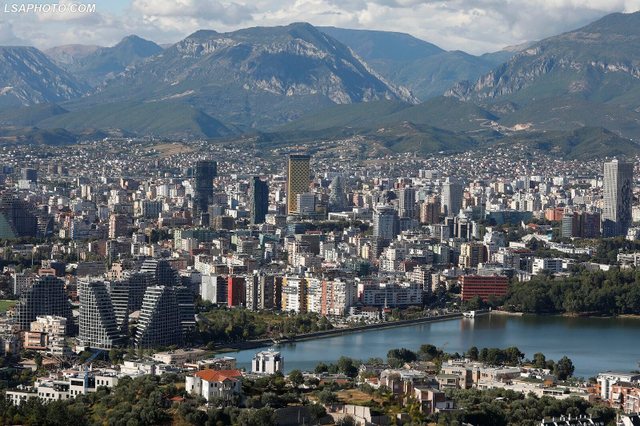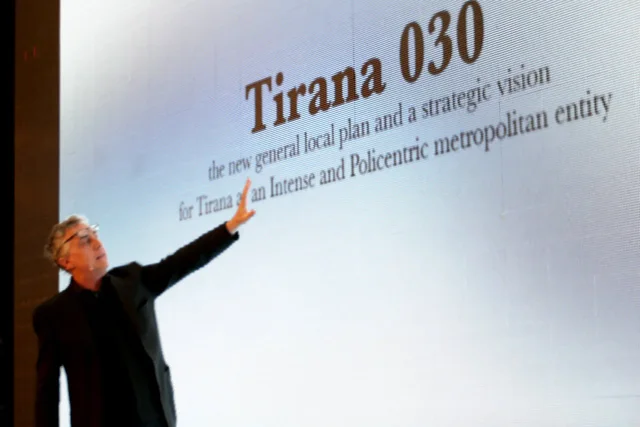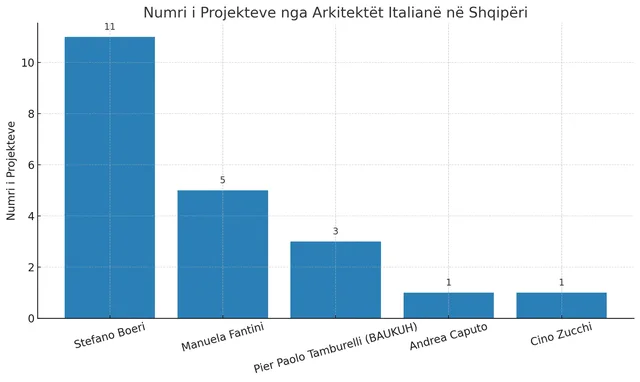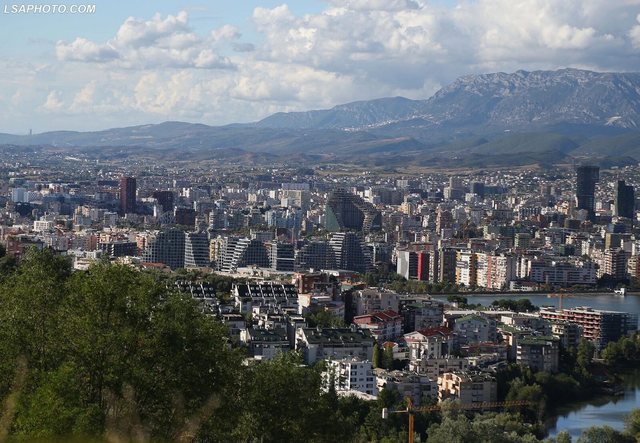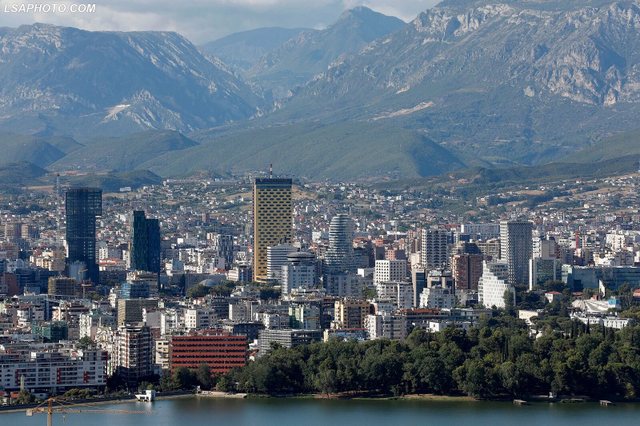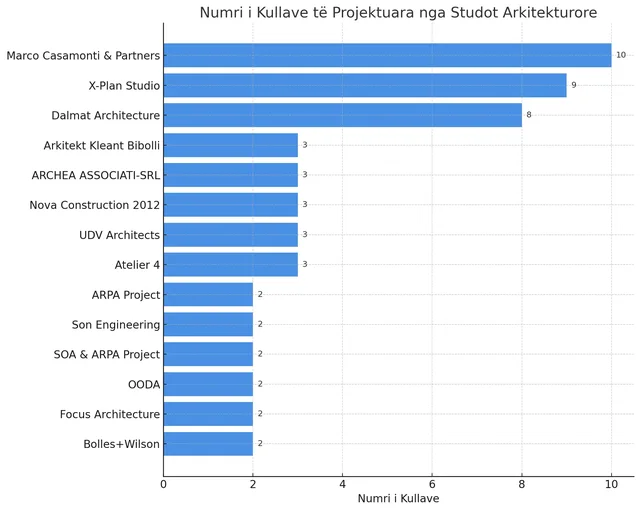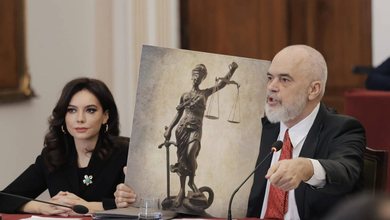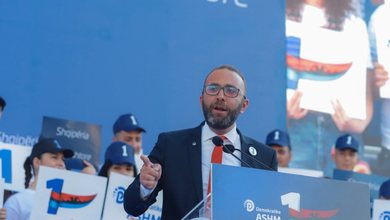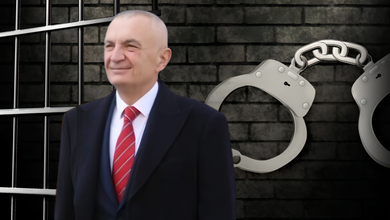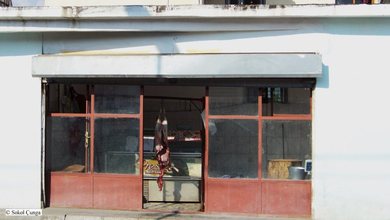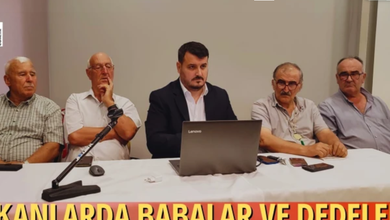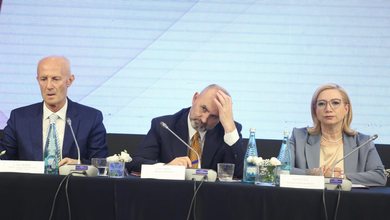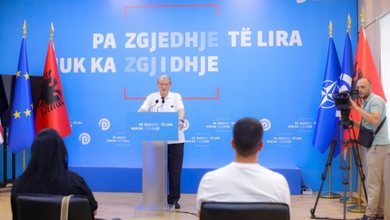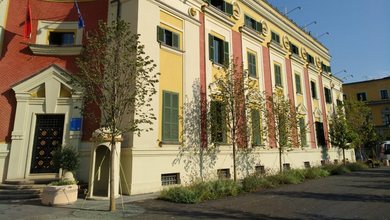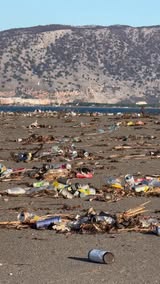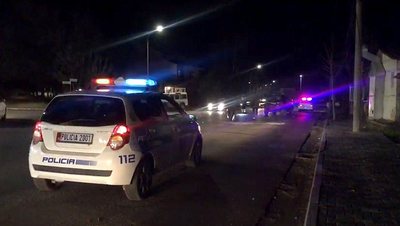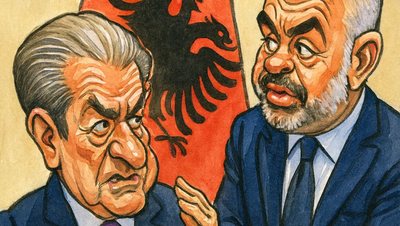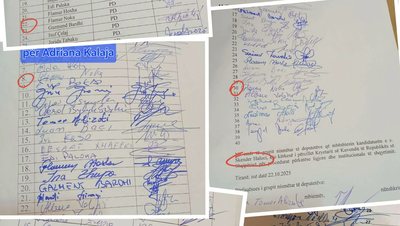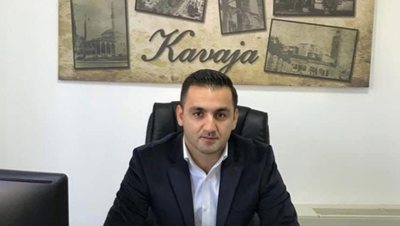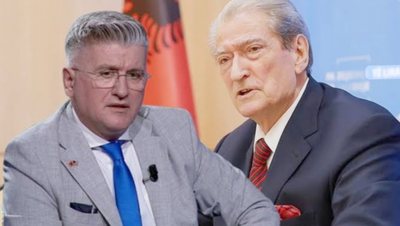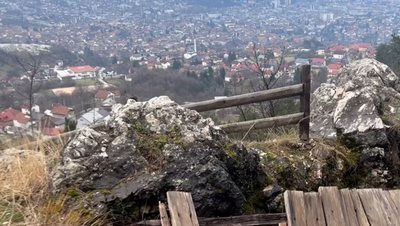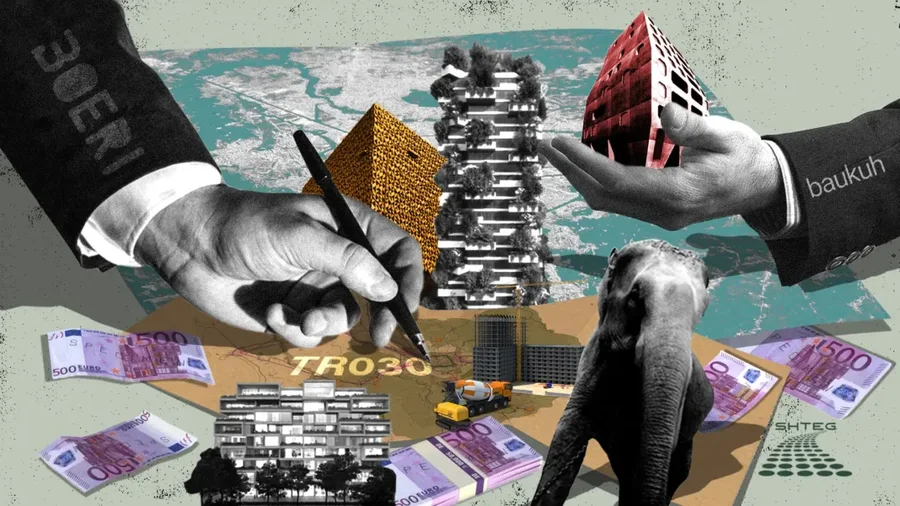
The towers that rise one after another, often without transparency and with little competition, show that architecture has become a tool for privilege where famous foreign names are involved in scandals and investigations. While the city loses greenery and public spaces, a concrete forest is destroying the urban and historical identity of the Albanian capital.
Every day, new tower silhouettes are born on the horizon of Tirana. The city, once surrounded by green hills, is becoming breathless amidst a concrete forest that is expanding without stopping. Behind the glass facades and modern designs hide decisions, agreements and interests that are rarely published and even less often analyzed.
"Albania produces more architecture than the rest of Europe," Prime Minister Edi Rama proudly declared during the Architecture Festival, which brought together hundreds of architects from around the world under the motto "Bread & Heart", held in Albania from June 5 to 7, 2025.
Data collected by the “shteg.org” platform shows that Albania has the highest level of contribution of the construction sector in Europe. While in the European Union construction represents an average of 5.6% of gross added value, in Albania this figure reaches 14.4%, according to Eurostat. In 2024 alone, according to data from INSTAT, Albanian authorities granted permits for the construction of 494 buildings, an increase from 411 in 2023, expanding the construction area to almost 2.5 million square meters.
During the period 2020–2024, over 11 million square meters of new construction have been approved, of which 8 million were completed in Tirana alone. The value of these investments, according to INSTAT, amounts to 485 billion lek, or about 4.8 billion euros. But behind this vigorous activity, a dark side is hidden. The US Department of State (DASH), in the Report on the International Narcotics Control Strategy 2025, warns that Albanian criminal groups are using the domestic economy, especially construction, to launder money gained from criminal activity.
According to the report: “Criminals launder proceeds through real estate purchases, construction projects, virtual assets, and business development.”
Local experts also raise the alarm that the construction sector has become an oasis for money laundering. According to a report by the Global Initiative (2022), in Albania, it is suspected that around 666 million euros have been laundered in the construction sector alone.
But beyond the construction boom and the questions raised by international reports and experts, data from “shteg.org” reveals that a small number of architectural studios dominate the entire sector. Over 200 buildings built in Tirana were designed by a narrow circle of studios, which raises concerns about competition and diversity in architecture.
From “Vertical Forest” to “Urban Concrete”

In the spring of 2016, a group of journalists, accompanied by the Mayor of Tirana, Erion Veliaj, traveled to northern Italy to visit the “Vertical Forest” in Milan, a project by renowned architect Stefano Boeri. This visit was not a coincidence.
That same year, Boeri was contracted by the Municipality of Tirana to draft the General Local Plan “Tirana 2030”, which included the vision of the “Orbital Forest”, a city covered in greenery, which would curb uncontrolled construction and create a balance between man and nature.
However, although this plan outlined clear construction restrictions, Boeri himself has designed buildings that exceed these limits, such as the Cube Block, the West Residence Block, and the Vertical Forest – all approved by the National Territorial Council, headed by the Prime Minister.
Boeri became so popular in the Albanian market that he opened a branch of his studio in Tirana. The office, part of the Milan-based company, provides services on public and private projects in Albania. In 2022 alone, this office reported revenues of 5.7 million euros.
Studio Boeri, in collaboration with other firms, has benefited from over 840 thousand euros from public contracts, including the design of the Tirana Riverside neighborhood, the construction of three public schools and the intervention in the Durrës Archaeological Park.
Tirana Riverside, a model neighborhood along the river, gained the status of a reconstruction project after the 2019 earthquake, which allowed authorities to bypass standard tendering procedures and entrust the project directly to Boeri's studio.
In August 2023, Studio Boeri won the competition to design a tower near the New Boulevard, in collaboration with Son Engineering, while a few months later it also won a 150 thousand euro tender for the design of the Road Transport Directorate building.
For the Italian architect, Albania has become a “golden land”, where he has carried out most of the projects since the Socialists came to power. Boeri was one of the 32 architects invited to Tirana in the spring of 2014, when Edi Rama, newly appointed Prime Minister, launched the initiative to build a new city, “Tirana of the Next Generation”.
The guests came with ideas, experience and a thirst to build. Today, their projects are no longer on paper: they have become reality. Towers that touch the sky, futuristic structures and numerous constructions have changed not only the physiognomy of Tirana, but also its spirit.
Public spaces have shrunk, while new buildings have been erected where monuments, historical buildings, and cultural heritage once stood. While some parts of society see this development as modernization, others experience it as the undoing of urban memory.
Architects under investigation
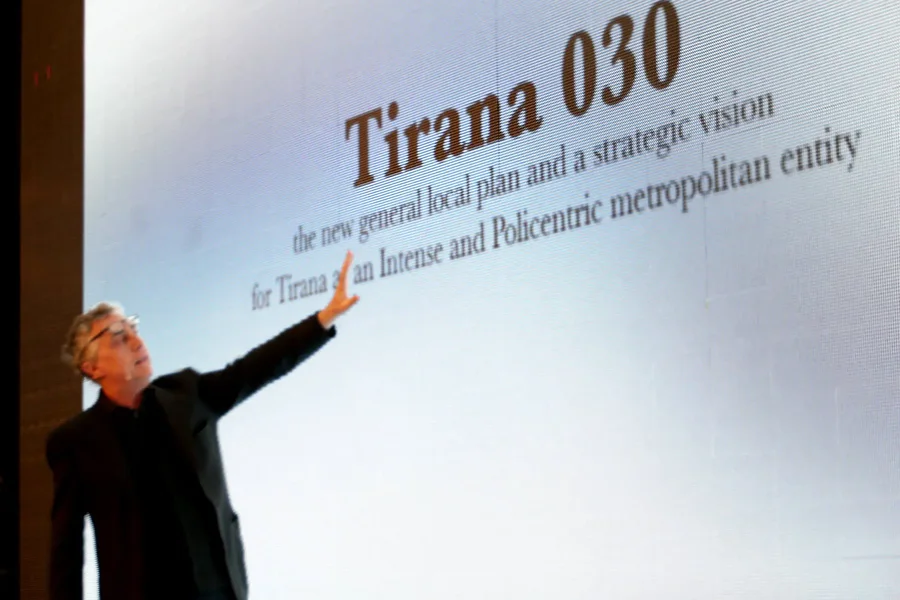
“I'm in Tirana. I'll be back on Friday.” The short message was sent on March 1, 2022. Italian architect Stefano Boeri was informing his old friend Paolo Tamburelli that he was in the Albanian capital.
Tamburelli soon returned with a specific request. He wanted Boeri's help in involving his studio "BAUKUH" in a 3.5 million euro project to build a university campus in Tirana.
A day later, Boer's phone rang again. It was Tamburelli on the other end. After they finished talking, the Italian architect got the details of the project.
Tamburelli asks Boeri to meet with Arbi, or the mayor, and emphasize the importance of involving BAUKUH as an overseer to guarantee the quality of the project.
In the messages that would later become part of the Milan Prosecutor's Office file, the project could be postponed and carried out "informally".
Against the backdrop of these conversations, a wide-ranging investigation was being conducted in Italy by the Milan Prosecutor's Office.
In 2024, the Milan Prosecutor's Office requested house arrest for Stefano Boeri and his colleague Cino Zucchi, accused of corruption and abuse of office in connection with the European Library of Information and Culture (BEIC) competition.
The prosecution's file included 70 people under investigation, among them: Stefano Boeri, Paolo Tamburelli, Manuela Fantini, Cino Zucchi, Andrea Caputo. Most of them had participated in projects in Albania. Only two of them, Floridi and Lunati, had no connection to our country.
The Italian architect is accused of manipulating one of the most important tenders of recent years: the construction of the BEIC, worth over 8.6 million euros.
Boeri was part of the commission that would select the winning project. He and his colleague, Cino Zucchi, had officially declared that they had no conflict of interest. But investigations revealed the opposite. They had direct contacts with one of the competing groups: ONISTESTUDIO BAUKUH SCE, precisely where Paolo Tamburelli was also a member.
The project was supposed to be anonymous, but documented messages and meetings showed that Boeri and Zucchi knew well which project they should support. Beyond professional connections, they had common academic, financial, and personal interests with the architects presenting that project.
On March 3, Boeri wrote to his friend: "I spoke to Arbi. We'll call you this afternoon."
At the time when Tamburelli sought Boeri's help for the university campus, Arbian Mazniku was still deputy mayor. He enthusiastically presented plans for the construction of the campus in the "Student City" area.

Credits: shteg.org – The number of projects carried out by some of the Italian architects in Albania
The Tirana University Campus has always been part of electoral promises, from 2015 when it was first floated as an idea, until February 2025, when the Minister of Education, Ogerta Manastirliu, promised that work would begin very soon at an inauguration ceremony for two dormitory buildings in the student city. To this day, there is nothing clear about this project, except for promises from the institutions.
The investigation and wiretapping of Boer also brings information regarding his activity in Albania.
Stefano Boeri, as head of the bid evaluation committee, announced the winner of the project, the group of architect Manuela Fantini.
The latter, with the SCE Project studio, has collaborated with Stefano Boeri on the Blloku Residence, Blloku Cube, Tirana Riverside and Vertical Forest projects. The parties will also collaborate on the construction of the General Directorate of Transport Building, where Boeri, according to the file, paid 12 thousand euros to Fantini just for collaborating on this project.
The Milan prosecutor's office requested house arrest for Boeri and his architect friends in January of this year.
The court rejected the prosecution's request, initially ruling out house arrest, but imposed milder measures for the 68-year-old in February. The architect is not allowed to participate in public competitions or be part of juries that award projects for a year. "I am very happy that house arrest was not accepted and I can continue my work as an architect and the projects I have," the Italian told the media in his country after the decision by the Milan Court.
Despite the initial accusations, Boeri appeared in Tirana at the “Bread and Heart” architecture festival. He gave a long speech explaining why he considered Tirana an “urban miracle.”
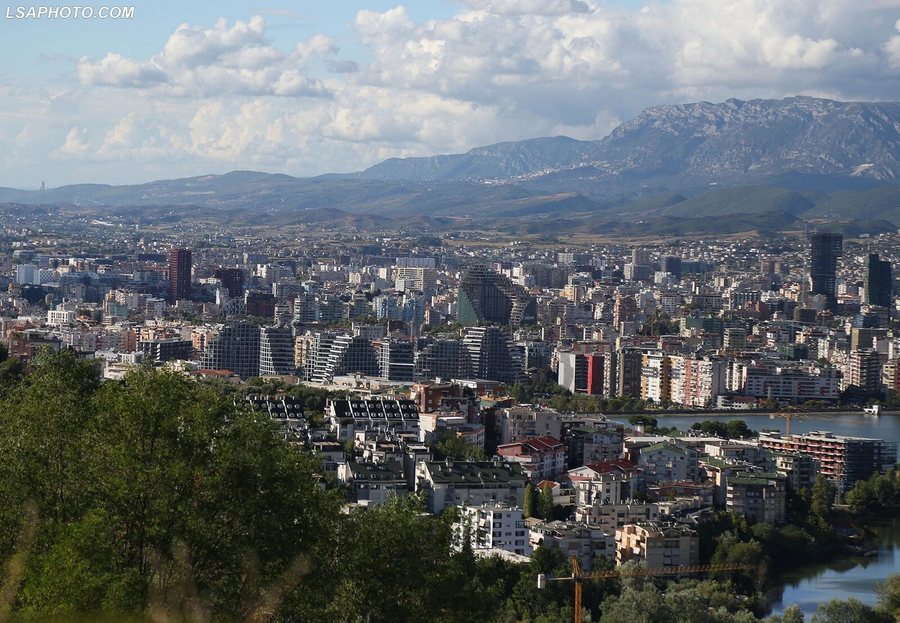
And while in Tirana he spoke to the audience about "The Morphology of a Vertical Forest", in Milan he was involved in another investigation by local authorities.
He was investigated by the Milan Prosecutor's Office for direct influence and pressure on the approval committees for his "Botanical Tower" project, part of the "Pirellino" dossier.
The former municipal palace was purchased by the construction entrepreneur, Manfredi Catella, and was designed to be transformed according to Boeri's idea into the "Botanical Tower".
The Landscape Commission in June 2023 rejected the project; according to them, it was too burdensome and unacceptable.
After the commission rejected the project, Boeri and entrepreneur Catella launched direct pressure on local officials and commission members.
The Italian prosecution documented numerous communications, including a message that Boeri sent to Milan's mayor, Giuseppe Sala: "Take it as a warning for tomorrow."
A day later, the commission changed its position and gave its approval. The Milan prosecutor's office considers this as open pressure and has taken a positive approach to the prosecution.
Boeri ka hedhur poshtë akuzat, duke thënë se është i bindur se kompania e tij ka vepruar brenda rregullave.
Prokuroria ka kërkuar arrestimin e 6 personave të cilët dyshohen për korrupsion në dhënien e lejeve për ndërtime në Milano. Mes emrave kryesorë të përfshirë, përveç arkitektit, është edhe kryetari i Bashkisë së Milanos, Giuseppe Sala.
Nuk është vetëm Boeri …
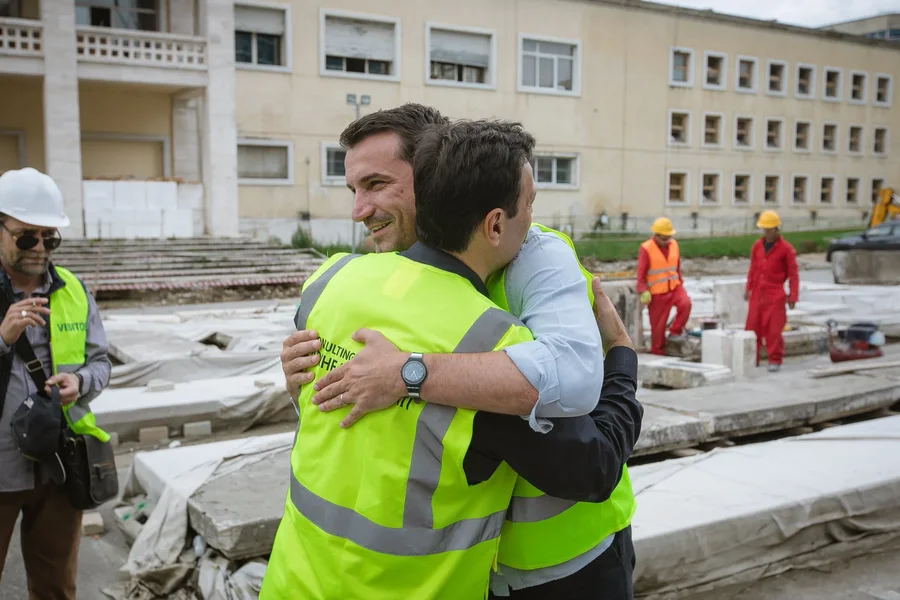
Probleme me drejtësinë italiane ka edhe arkitekti i 10 kullave që kanë kapur qiejt e Tiranës, Marco Casamonti.
Themelues i studios ndërkombëtare Archea Associati, ai është përfshirë në disa hetime penale në Itali që lidhen me korrupsion dhe manipulim tenderash. Në Firence, Casamonti është arrestuar si pjesë e një hetimi për manipulimin e një tenderi të prokuruar nga Komuna e Terranova Bracciolini (Arezzo), për një projekt rinovimi me vlerë 98 mijë euro.
Sipas prokurorisë, ekziston dyshimi se Casamonti dhe ish-këshilltari komunal Gianni Biagi kanë ndërhyrë për të favorizuar përzgjedhjen e profesionistëve të afërt me grupin Ligresti në projektin e urbanizimit të Kalasë së Firences, një pronë në zotërim të kompanisë Fondiaria-Sai.
Hetimet, të drejtuara nga prokurori Giuseppe Quattrocchi, kanë përfshirë gjithashtu zyrtarë publikë dhe profesionistë të tjerë. Për Casamontin, autoritetet kanë ngritur shqetësime për rrezik të përsëritjes së veprës penale.
Pavarësisht akuzave në vendin e tij, Marco Casamonti ka qenë një figurë qendrore në zhvillimet urbane në Shqipëri gjatë dekadës së fundit.
Ai hyri në tregun shqiptar me projektin e kullës Forever Green, e vendosur përballë Kishës Ortodokse në Tiranë, dhe më pas projektoi stadiumin Air Albania.
Ky i fundit u ndërtua nga kompania Albstar, e cila financoi të gjithë projektin në këmbim të të drejtës për të ndërtuar një kullë shumëkatëshe brenda kompleksit të stadiumit.
Në atë kohë pati një debat të madh në Shqipëri lidhur me shembjen e objektit të vjetër, që ishte pjesë e ansamblit të Bosio-s, arkitektit italian që ka projektuar një sërë ndërtesash në qendrën e qytetit gjatë pushtimit fashist, të shpallur “monument kulture”.
Që nga viti 2016, përmes studios Archea Albania, Casamonti ka hartuar një sërë projektesh të mëdha si në sektorin publik, ashtu edhe në atë privat. Ai ka përfituar kontrata përmes procedurave me negocim të drejtpërdrejtë, përfshirë përgatitjen e planit të detajuar vendor për zonën e Kombinatit me vlerë 200 mijë euro, si dhe është shpallur fitues i tenderit për masterplanin ajror të aeroportit të Vlorës në bashkëpunim me një firmë shqiptare.
Casamonti është autori i disa prej ndërtesave më të mëdha në Tiranë. Një kullë 25-katëshe në rrugën Liman Kaba, me leje ndërtimi të dhënë më 1 gusht 2023, me investitor firmën Unico Construction, mban firmën e tij. Po ashtu edhe një hotel 12-katësh në zonën e ish-Bllokut dhe një kullë 30-katëshe në lagjen Don Bosko, projekte të biznesmenit Lefter Sota, janë projektuar nga arkitekti italian.
Dy kulla të tjera shumëkatëshe në Tiranë, përkatësisht me 56 dhe 44 kate, në Bulevardin e Ri dhe Bulevardin “Gjergj Fishta”, po ashtu janë projektuar nga studio e tij, ndërsa gjashtë godina në zonën e Liqenit Artificial, pranë hotelit Mak Albania, janë në ndërtim e sipër.
Pjesëmarrja intensive e studios së Casamontit në transformimin urban të Tiranës ka ngjallur debat dhe shqetësim publik, veçanërisht për faktin që projektet e tij kanë ndikuar në ndryshimin e peizazhit historik dhe urbanistik të qytetit.
Pushteti i arkitektëve së huaj
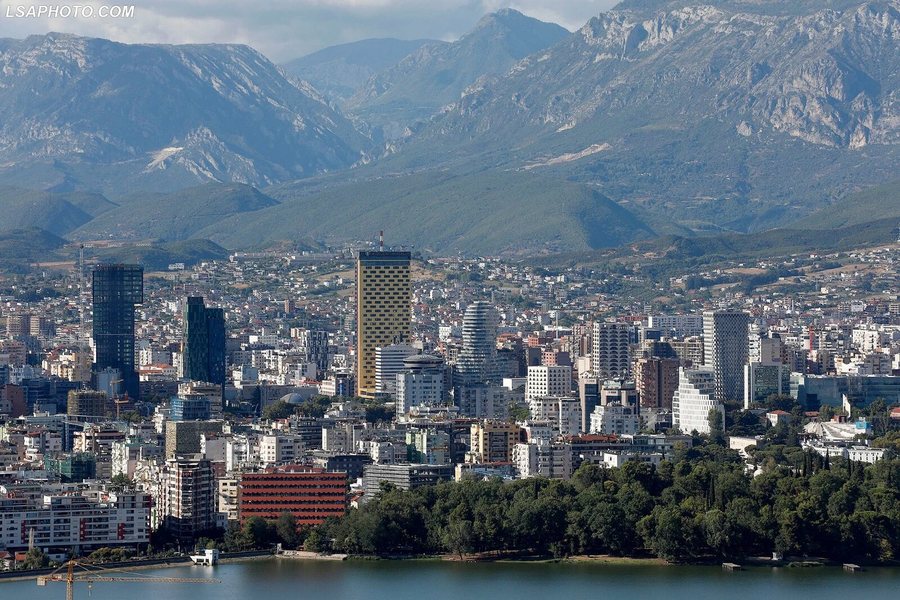
Çdo rrugë e re, çdo bulevard dhe çdo shesh në Tiranë sot shoqërohen me firmat e huaja të arkitekturës që dominojnë skenën urbane.
Qyteti është kthyer në një terren të hapur për studio ndërkombëtare, të cilat në vendet e tyre veprojnë me standarde shumë të rrepta profesionale, por në Shqipëri kanë akses të veçantë dhe shpesh përfshihen në kontrata pa konkurrencë.
Kjo politikë e përfshirjes së arkitektëve të huaj nisi me Edi Ramën si kryetar bashkie. Plani Urbanistik i Tiranës, dy dekada më parë, u përcaktua përmes një konkursi në vitin 2003, nën koordinimin e tij.
Fitues u shpall plani i francezëve të Architecture – Studio, ndërkohë që konkuruan edhe gjermanët e Bolles & Wilson dhe firma belge 51N4E.
Në dy dekadat që pasuan, dy studiot e huaja janë përfshirë në projektet më të rëndësishme ndërtimore në vend.
Firma belge 51N4E ka luajtur rol kryesor në hartimin dhe mbikëqyrjen e Sheshit Skënderbej, Qendrës për Hapje dhe Dialog në Kryeministri, dhe në zhvillimin e disa zonave të Tiranës, duke punuar me Fondin Shqiptar të Zhvillimit. Së fundmi, ajo mori “Masterplanin për kompleksin sportiv të stadiumit Niko Dovana” në Durrës, përmes një procedure negociimi pa garë, me një kontratë prej 440 mijë eurosh.
Gjithashtu, 51N4E ka projektuar më parë Lumin e Lanës, bllokun Noka, kullën TID ku ndodhet hoteli Maritim Plaza, si dhe Godinën Book Building pranë Kullës së Sahatit, monument kulture i kategorisë së parë.
Edhe pse dega e kompanisë në Tiranë u themelua në vitin 2008 dhe në fillim nuk ishte shumë aktive, të ardhurat e saj nisën të rriten ndjeshëm nga viti 2013, duke arritur në 100 mijë euro. Në vitet e fundit, arkëtimet mesatare kapin mbi 500 mijë euro, ndërsa në vitin 2022, 51N4E regjistroi 910 mijë euro të ardhura dhe 330 mijë euro fitim pas taksave.
Në total, gjatë 10 viteve të fundit, firma belge ka realizuar 5.3 milionë euro të ardhura dhe 1.8 milionë euro fitim neto.
Studio gjermane Bolles & Wilson ka ndërhyrë në qytetin e Korçës, duke realizuar projekte si Pazari i Vjetër dhe biblioteka publike. Megjithë vlerësimet pozitive për cilësinë, këto projekte janë rezultuar me kosto të larta dhe pa konkurencë.
Ajo ka fituar gjithashtu projekte nën ombrellën e Rilindjes Urbane, të cilat ishin në portofolin e zëvendëskryeministrit Niko Peleshi gjatë viteve 2015-2017.
Bolles & Wilson ka marrë dy kontrata nga Fondi Shqiptar i Zhvillimit, njëra përmes negociimit pa garë dhe tjetra si fituese, edhe pse ofroi çmimin më të lartë. Studio është autore e shtesës 33-katëshe pranë Hotel Tiranës dhe një godine 27-katëshe në rrugën Gramoz Pashko.
Holandezi MVRDV ka kontribuar në transformimin e Piramidës së Tiranës në bashkëpunim me AADF, ku arkitekti kryesor është Winnie Mass.
Mass vizitoi Shqipërinë për herë të parë në vitet kur Edi Rama nisi ngjyrosjen e fasadave të pallateve si kryebashkiak. Ai hartoi në vitin 2008 planin për Sheshin Skënderbej, projekt i financuar nga bashkia dhe qeveria e Kuvajtit, por që nuk u zbatua për shkak të kundërshtive politike.
Në 2014, Mass u rikthye dhe që nga ajo kohë ka qenë autor i shumë projekteve private dhe i planit për restaurimin e Piramidës, projekt i mbështetur nga Fondi Shqiptaro-Amerikan i Zhvillimit. Në vitin 2018, MVRDV mori kontratë për restaurimin e mauzoleut të ndërtuar në nder të diktatorit Enver Hoxha.
Qëllimi ishte që ndërtesa të ishte e hapur për publikun dhe të shërbente si qendër trajnimi në teknologji dhe inovacion për të rinjtë.
Projekti u realizua nga kompania vendase Fusha, ndërsa punimet iu nënshtruan rregullave të prokurimit publik, pasi pjesë e financimeve erdhën nga buxheti i shtetit.
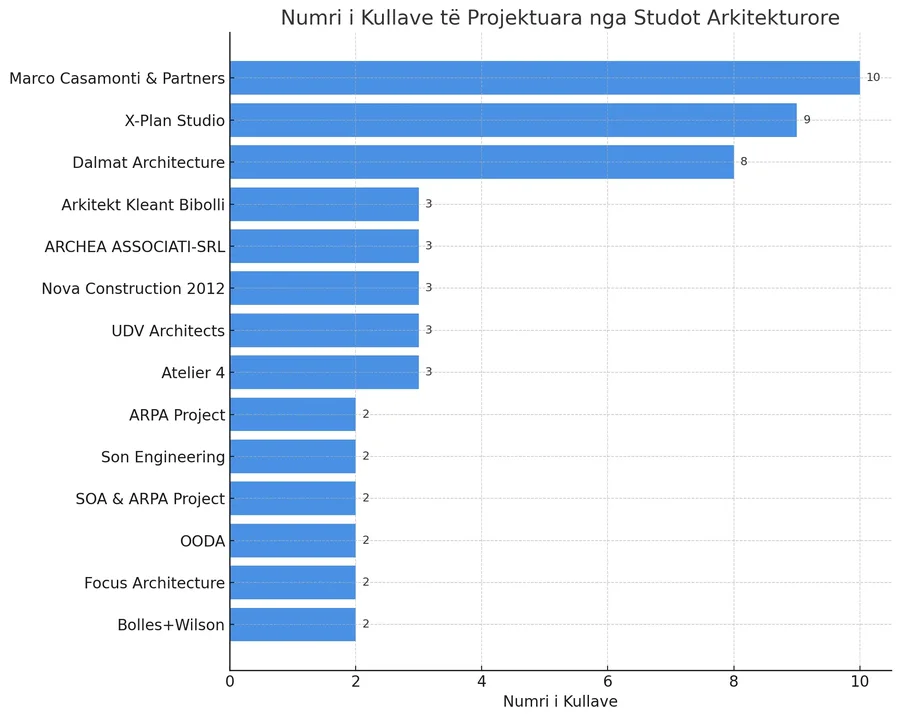
Studio MVRDV është angazhuar edhe në ndërtimin e Down Town One, një nga godinat më të larta në kryeqytet, për Kastrati Construction. Fillimisht projekti parashikonte një ndërtesë 37-katëshe për rezidenca dhe zyra, por më pas u shtuan kate shtesë për hotel.
Një tjetër projekt i holandezëve është Kulla e Skënderbeut, pranë Hotel Tiranës, e dizajnuar me elemente që nderojnë heroin kombëtar.
Kompania ka punuar më parë për qendrën tregtare Toptani dhe projektin fillestar të kullave te Liqeni Artificial, projekti i fundit që nuk u realizua sipas idesë së tyre.
Në vitin 2010, arkitekti danez Bjarke Ingels, kreu i studios ndërkombëtare BIG, vizitoi Shqipërinë dhe projektoi Muzeun e Tolerancës Fetare, një ide që nuk u realizua për shkak të përplasjeve politike mes bashkisë dhe qeverisë.
Ai u rikthye në 2017 dhe u kontraktua nga kompania Fusha për të projektuar Teatrin Kombëtar. Projekti u kundërshtua nga artistë, aktivistë, organizata ndërkombëtare dhe partitë opozitare, ndërsa procedura e ndërtimit u konsiderua e paracaktuar.
Teatri u shemb më 17 maj 2020, në kulmin e pandemisë Covid-19, dhe bashkia hap një tender për projektimin e tij me të njëjtin dizajn, ku fitues ishin A&E Engineering dhe FM Ingegneria, me kontratë 720 mijë euro.
Shumë prej ndërtesave të mëdha realizohen nga studio të huaja, që krijon probleme në planifikimin urban, pasi nuk përfshijnë mjaftueshëm kulturën dhe terrenin lokal.
Inxhinieria Luljeta Bozo shpreh se nuk është dakord që shumica e projekteve të mëdha t’u jepen vetëm studiove të huaja, pasi ata nuk njohin historinë dhe kontekstin ashtu si shqiptarët.
"I do not agree that most large projects should be realized and won by foreign studios. We have very good designers, architects and engineers. Of course, for very tall towers and giant projects there will be collaborations between foreign and Albanian studios, but they should not be only foreigners. They cannot know the history, relief and context as Albanians do," says construction engineer Luljeta Bozo, for "shteg.org".
Eduart Ndoci, a real estate agency manager, says the market is no longer optimal, prices have increased significantly, and this has created difficulties for buyers. He does not rule out that the influence of foreign architectural studios could be an additional factor.
"The market is not the best possible, there have been many problems. Prices have increased a lot and of course there have been difficulties for people to buy entrances. I can't say for sure if foreign architectural studios have also had an impact, but I think this could be the reason," says Eduart Ndoci.


